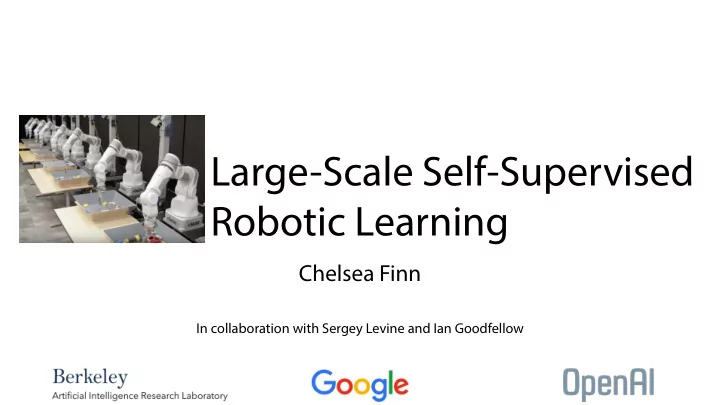

Large-Scale Self-Supervised Robotic Learning Chelsea Finn In collaboration with Sergey Levine and Ian Goodfellow
Generalization in Reinforcement Learning to object instances to tasks and environments Oh et al. ‘16 Pinto & Gupta ‘16 Levine et al. ‘16 Mnih et al. ‘15
Generalization in Reinforcement Learning need data scale up First lesson : human supervision doesn’t scale (providing rewards, reseting the environment, etc.)
Generalization in Reinforcement Learning need data scale up where does the supervision come from? self-supervision most deep RL algorithms learn a single-purpose policy learn general-purpose model Evaluating unsupervised methods? lacking task-driven metrics for unsupervised learning
Data collection - 50k sequences (1M+ frames) test set with novel objects data publicly available for download sites.google.com/site/brainrobotdata
Train predictive model convolutional LSTMs action-conditioned stochastic fm ow prediction - feed back model’s predictions for multi-frame prediction - trained with l 2 loss
Train predictive model stochastic fm ow prediction ^ ^ I t I t+1 Stacked ConvLSTM masks transform parameters . * transformed images
Train predictive model convolutional LSTMs action-conditioned stochastic fm ow prediction evaluate on held-out objects Are these predictions good?
Train predictive model Finn et al., ‘16 Kalchbrenner et al., ‘16 Are these predictions good? accurate? useful?
What is prediction good for? action magnitude: 0x 0.5x 1x 1.5x
Visual MPC: Planning with Visual Foresight 1. Sample N potential action sequences 2. Predict the future for each action sequence 3. Pick best future & execute corresponding action 4. Repeat 1-3 to replan in real time
Which future is the best one? Specify goal by selecting where pixels should move. Select future with maximal probability of pixels reaching their respective goals.
0x We can predict how pixels will move based on the robot’s actions 0.5x 1x 1.5x output is the mean of a probability distribution over pixel motion predictions
How it works “Type a quote here.” –Johnny Appleseed
Does it work? - evaluation on short pushes of novel objects - translation & rotation Only human involvement during training is: programming initial motions and providing objects to play with.
Outperforms naive baselines “Type a quote here.” –Johnny Appleseed
Takeaways Bene fj ts of this approach - learn for a wide variety of tasks train visual foresight - scalable - requires minimal human involvement model - a good way to evaluate video prediction models unlabeled video experience Limitations indicated goal - can’t [yet] learn complex skills - compute-intensive at test time - some planning methods susceptible to adversarial examples
Future challenges in large-scale self-supervised learning better predictive models task-driven exploration, attention long-term planning - hierarchy - stochasticity learn visual reward functions
Collaborators Thanks to… Vincent Vanhoucke Peter Pastor Ethan Holly Jon Barron Ian Goodfellow Sergey Levine Bibliography Finn, C., Goodfellow, I., & Levine, S. Unsupervised Learning for Physical Interaction through Video Prediction . NIPS 2016 Finn, C. & Levine, S. Deep Visual Foresight for Planning Robot Motion . Under Review, arXiv 2016.
Questions? cb fj nn@eecs.berkeley.edu All data and code linked at: people.eecs.berkeley.edu/~cb fj nn
Collaborators Thanks to… Vincent Vanhoucke Peter Pastor Ethan Holly Jon Barron Ian Goodfellow Sergey Levine All data and code linked at: people.eecs.berkeley.edu/~cb fj nn Questions? cb fj nn@eecs.berkeley.edu
Thanks! Takeaway : Acquiring a cost function is important! (and challenging)
Sources of failure : model mispredictions “Type a quote here.” - more compute needed - occlusions - pixel tracking - –Johnny Appleseed
This is just the beginning… Collecting data with a purpose. Can we design the right model? stochastic? - longer sequences? - hierarchical? - deeper? - Can we handle long-term planning?
Recommend
More recommend